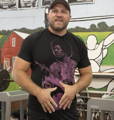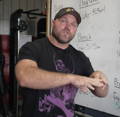The Right Type Of Strength Training - From Football to Tennis
The Right Type Of Strength Training - From Football to Tennis
As you think about the traditional thoughts around strength and what it means concerning athletes tends to conjure images of big, hulking individuals in the bodybuilding community. People like Arnold Schwarzenegger come to mind.
Parents of young athletes will look at bodybuilders and be like, “My kid plays tennis and my other kid is swimming. They don’t need that type of strength.” Thinking that way is wrong. All athletes need strength. However, you need to view strength in different formalities. For instance, if you are sprinting a 100-meter race, you have to have a lot of strength to come out of the block and strength specific to the movements of striking the feet and reacting. Your strength has to be specific to the movements.
You can classify specific strength characteristics by sporting needs. You want to classify by field sport (football, soccer, lacrosse, etc), combat sport (wrestling, boxing, judo, MMA, etc.), power sport (throwing, gymnastics, etc.), racket/court (volleyball, tennis, badminton, etc.), and cyclical endurance (5k, marathon, rower, road cycling, etc.). You have to look at strength as specific to the needs that allow you to produce a large amount of force and impulse specific to the muscular actions demanded from the sport. Strength is not just Arnold walking around doing strict preacher curls.

Strength Characteristics
Strength characteristics transfer over to various motor patterns.
A key characteristic of strength is blast impulse. Blast impulse is how much force you can produce in a very limited amount of time. Think of jumps, sprinting foot strikes, and throwing. Blast impulse plays a large role.
Sustain impulse is similar to blast impulse but lasts longer. Think of a scramble in wrestling or making contact on the line scrimmage and having to hold the block or shed the block. Sustain impulse requires producing a large amount of force for a longer time.

Another key strength characteristic you want to develop is power production for 15+ seconds. You can call it “power 15+”. Weightlifters have to do this often with a clean and jerk. Wrestlers have to do this as well. Sprint cyclists on a velodrome track need to go around at very high speeds with large amounts of power in each stroke in the “power 15+” range.
This takes us into power endurance. Some people claim that power endurance is a subcategory of power-based training. It needs to be its strength characteristic. Any combat athlete, ice hockey, or football player needs power endurance.
Finally, there is “endurance 90+”. Here the time spent covers a large range of time. The time can range from an 800-meter run to a marathon to a bike tour of a country. You need to train differently based on the endurance needed.
If you are a multiple sport athlete, you want to pick the top 3 strength characteristics for your training.
Field Sports
You need to begin by identifying the sports. You have field hockey, lacrosse, football, soccer, and many more.
You then need to highlight the needed strength characteristics for field sports. For field sports, you will identify sustained impulse, power 15+, and endurance 90+.
After identifying the sport and specific characteristics, you want to identify specific exercises. You will want to use technical coordination exercises like power cleans, behind-the-neck jerks, and full cleans to make you more coordinated, improve sustained impulse, and enhance your power 15+ capabilities.
You need to do plyometric work. You want to do unilateral and bilateral plyometric work to help you coordinate at a high rate. You will find that your power 15+ and sustained impulse will benefit.
It is important to attack absolute strength movements. You want to push your back squat, front squat, and bench press. Absolute strength is great for the power 15+ strength characteristic.
Reflexive strength work is necessary to improve your coordination from sport-specific positions. You want to break down the sport and create 3 to 4-step drills that will support your athletic development.
That leaves the supporting factor of endurance 90+. To train this strength characteristic you want to go in the sauna, perform long slow distances, do cyclical work on an assault bike, or do pushes and pulls with a sled for 15 minutes.
Power Sports
You can identify power sports as sprint cycling, weightlifting, throwing, and, to a point, powerlifting. Think about being as explosive as possible. With power, you are better served to look at it through the term impulse (producing a large amount of force in a very restricted time).
Having identified power sports and understanding what type of force output is needed, you can look at what strength characteristics are needed for training. Immediately, your mind goes to blast impulse. That BOOM!!! right away, as explosive as possible. Jumping, sprinting, and all of those areas will help you with power sports.
Sustained impulse is needed as well with its slightly longer periods of the force application.
Finally, power 15+ is a necessity. You need to train this strength characteristic to develop power-based force because time under tension does add up. Just think of the time spent taking a back squat out of the rack, squatting the weight, and reracking the weight. Or performing a clean and jerk.
Specific training for power-based sports requires technical coordination exercises like power snatches, cleans, jerks, push presses, and so many more. Technical coordination movements benefit power-based sports tremendously.
The same goes for absolute strength work benefiting power-based sports. Back squats, front squats, pulls, single-leg squats, and pressing are all exercises that develop absolute strength.
Plyometric work and reflexive work subsidize all the absolute strength work. Plyometric work and reflexive work will teach your body how to rapidly coordinate to become a freak athlete through your absolute strength.

Combat Sports
Always, you want to first identify the sports. A few combat sports you can identify are wrestling, judo, BJJ, boxing, and MMA. You then want to identify the top 3 strength characteristics you need for combat sports training.
The top 3 strength characteristics are sustained impulse, power endurance, and traditional endurance as the supporting, underlying factor. Sustained impulse is explosive, power endurance allows you to be explosive late in the match, and traditional endurance allows you to hold a high heart rate for a long time and still produce force.
Technical coordination movements will support sustained impulse development and factor into combat sports. You will become more explosive by utilizing technical coordination movements.
You can get creative with technical coordination movements by using on-the-minute tricks, higher rep sets, and shorter rest periods to increase sustained impulse while also catering to power endurance.
For endurance-based work, you need to do high-intensity interval-based training, sprint interval training, and long slow distance training of 45 to 60 minutes to develop your endurance base.
Ideally, where everything gets molded together is doing plyometric exercises and reflexive exercises while under fatigue. You may be thinking that you shouldn’t be doing plyometrics or reflexive exercises while fatigued. However, combat sports are about doing explosive movements while fatigued. It bodes well for you to train in that cognitive and physical predicament.
Racket Sports
You want to think of racket sports as anything with an arm swinging an implement. So this includes baseball, tennis, and badminton to name a few. Racket sports are complicated and super explosive.
Racket sports need to develop blast impulse. Reacting to a ball coming off a racket or bat requires that you are explosive and fast to track the ball down.
The power 15+ needs to be trained because you will find yourself in long volleys. You also have to train power endurance so that you can produce a lot of power over a long time so you compete late in the match.

With the training, you have to perform technical coordination movements. You need to be able to throw the brakes on fast to decelerate rapidly. A power clean will require you to stop the weight and develop dynamic trunk control.
You also want to train plyometric movements with a focus on deceleration movements. A depth drop works here. As a racket sport athlete, you also want to perform reflexive-based exercises to improve your rate of coordination.
It is also necessary as a racket sport athlete that you do plyometrics under some sense of fatigue. You can reserve specific days to being as explosive and reactive as possible while somewhat fatigued. You also need to reserve specific days to be as explosive and reactive as possible while well rested between displays of strength.
Cyclical Endurance
Marathons, rowing, 5ks, swimming, and any other examples of long slow distance sports that take a LONG time to cover distance fall under cyclical endurance.
You can begin with power 15+. You are scratching your head right now. Think about this: if you can be more explosive and have a higher power output, you will have longer strides and use less energy to cover the same distance, benefiting from the power 15+. The same concept goes for swimmers and other cyclical endurance athletes.
You also have to prioritize. You want power endurance. Producing a large amount of power over a long time will allow you to be pretty good at your sport. Power endurance also feeds right into endurance 90+.
Endurance 90+ allows you to execute for 30 minutes, 60 minutes, and even longer. Demands may be in multiple hours. Training in such time ranges with an elevated heart rate is necessary to develop a sound foundation for endurance-based training.
You still need to do technical coordination movements for cyclical endurance sports because the power 15+ is a characteristic to be targeted. Stronger muscles lead to fewer strokes in the pull and strides in the race. Technical coordination movements transfer to endurance-based work.
Unilateral absolute strength work, like the single-leg squat, is great. You can pick up a single-leg roller here. It will help with hiking and running tremendously.
You also want to get into reflexive-based work to improve power-based work.
And obviously, you need to do long slow distance work. Try doing long hill sprints at 65-75% intensity for 45 minutes and see how your endurance 90+ improves.
Recap
Identify the sport classification. Identify the specific sport(s). Identify the top 3 strength characteristics. Identify what it means in the weight room and training. You can take specific exercises and understand where you can plug each movement to benefit your strength characteristic goals.
Want to bring your training to the next level?
Check out online training app - Peak Strength
Related Posts
Blog Topics

Yo, It's Dane
Welcome to the Garage Strength Blog, where it is my goal to provide you with the experience and knowledge I've gained in the strength and conditioning world over many years of learning from both successes and failures. I train elite-level athletes in a multitude of sports from the high school to professional levels, already producing 5 Olympics and 30+ National Champions. If you want to be the next champion I train, check out my strength programs below!
Start Training With Me

Join for free educational videos EVERY WEEK on strength coaching and athletic performance



